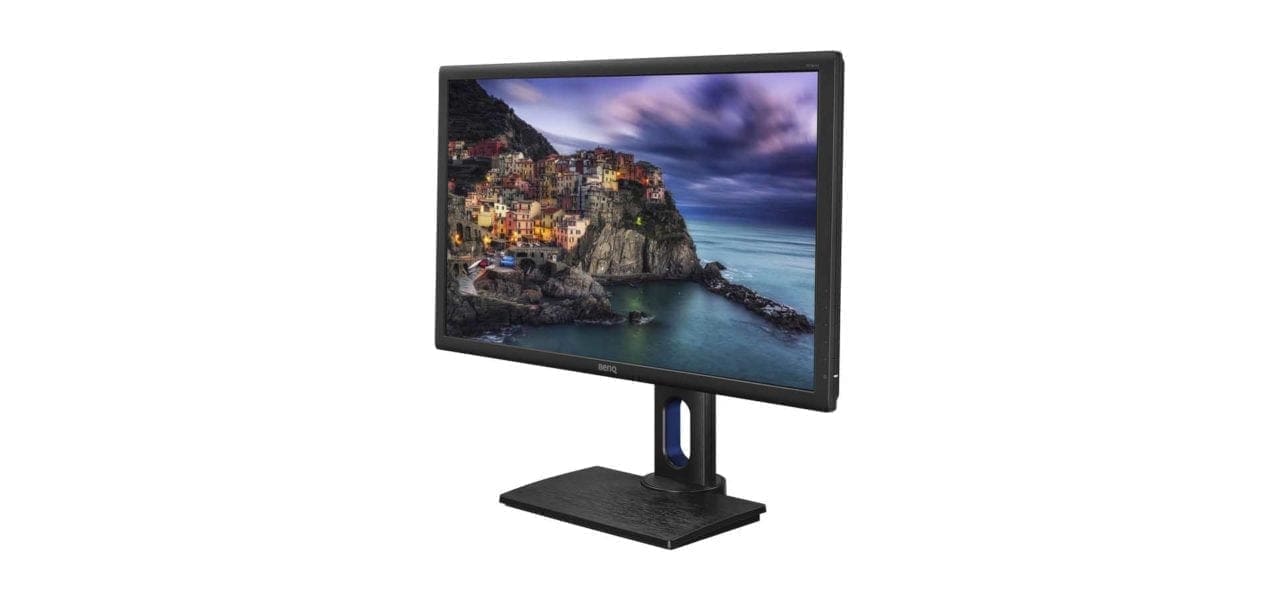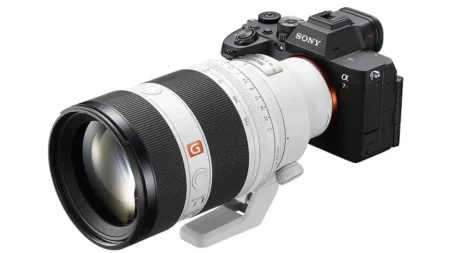With post-processing becoming so important these days, the monitor has almost become an extension of the camera – that ultimate playback mode where clarity is crucial to fine-tuning your images.
The BenQ PD2700Q is the middle sibling of a new trio of monitors the company has launched (sitting in between the Pro model SW2700PT and ‘Everyday’ BL2700HT) aimed at ‘content creators’, and on paper it really is a solid all-rounder.
The 27in monitor offers 2560 x 1440 QHD resolution on its non-reflective screen, along with 1.07 billion display colours in 100% sRGB and Rec.709 mode, with 10-bit colour depth.
Other features include BenQ’s DualView, ZeroFlicker and Low Blue Light display settings and a Darkroom Mode, as well as CAD/CAM (high contrast) mode and a number of customised setting features. You can also choose from four colour temperature modes: normal (6500K), reddish (5700K), bluish (9300K) and a user mode where you can take control and fine-tune your colours.
The BenQ PD2700Q is also built with what is called an In-Plane Switching (IPS) panel that offers users 178° viewing angles.
Another cool feature is its Desktop Partition capability. Using BenQ’s Display Pilot software, which comes with the monitor, you can set up to four Desktop Partitions – essentially four screens within your screen.
The BenQ PD2700Q weighs 6.9kg (about 15lbs) and is 21.5 x 25.2 x 9.4in (547.32 x 641.0 x 239.65mm) in size. It can be wall mounted, while it’s stand offers 130mm height adjustment and is detachable.
BenQ PD2700Q Build Quality
The BenQ PD2700Q feels very robust for a mid-range monitor and is a solid piece of kit. The monitor rests on a weighty support stem, which screws into the back of the screen and keeps it remarkably stable and still.
On this stand you can slide the BenQ PD2700Q up to adjust its height, or tilt sideways in each direction to change its angle.
It’s a little difficult to get a sense of this in words, so I filmed this quick video to demonstrate the BenQ PD2700Q’s different height and viewing angles, and how easy it is to adjust.
The BenQ PD2700Q’s design is quite minimalist and easy to navigate. On the right-hand side of the monitor is a column of buttons, which are your main controls for adjusting settings like brightness, sound and employing a range filters on your screen.
Again, these are best conveyed by seeing them so I filmed this short video to showcase the different menu options.
On the back of the monitor the cables can be funnelled behind the stand, which keeps things relatively tidy; however, an improvement in future would be the ability to guide these cables through the central column of the stand.
There’s no shortage of ports, though; the BenQ PD2700Q offers an HDMI input, three USB 2.0 ports (one upstream and two downstream) audio output and both full size and Mini DisplayPort inputs.
BenQ PD2700Q In Use
Using the monitor with my Macbook I was immediately impressed by its crisp, clear 2.5K resolution. Images I thought looked flat on my Mac’s screen were rich and vibrant when dragged over to the BenQ PD2700Q.
I like to work across two monitors when I’m editing images, opening a folder in Bridge on one screen and Photoshop on the other. The size of the BenQ PD2700Q, though, means I can quite easily work on one screen and view my images both in Bridge and opened in Photoshop in high resolution.
All of the monitor’s controls and features can be accessed via a column of six buttons (one of which is the power button) along the lower right side of the PD2700Q. When you press one, a menu system appears on screen, which you can see in the video above.
What I really liked about using the BenQ PD2700Q was being able to adjust its height and angle. I don’t sit still in one place for long, so being able to rotate the monitor 45 degrees or tilt it up 25 degrees was nice.
BenQ bills the PD2700Q as being ready to use with out-of-the-box accuracy. The monitor looks great displaying all sorts of content, and in particular was its nice level of contrast. This made colours pop and images look pin-sharp.
Grayscale also looks bright and punchy, and you can also choose from a range of presets that alter the PD2700Q’s tint.
BenQ doesn’t offer factory-certified calibration with the PD2700Q, but this isn’t a monitor aimed at professionals. It’s a straight, middle-of-the-road monitor, but it actually packs a lot more punch performance-wise than other monitors in this class.
You do have some control over colours, however, by switching to the User mode and adjusting the RGB sliders
Lastly, it’s worth noting that the BenQ PD2700Q does have two integrated speakers. They sound sound a little tinny, but then you’re likely not buying this to watch Game of Thrones. It’s a nice feature to have, though, if you want some background music while ploughing through a few hundred images from your holiday.
BenQ PD2700Q Review: Verdict
The BenQ PD2700Q offers good value for money. It offers 2.5K resolution and 1.07 billion colours which, at a sub £400 / $400 price tag, is a lot more spec than other monitors in its class.
Sure, there are a lot of new 4K monitors out there which might offer a more stunning viewing experience, but if you don’t shoot stills or video in 4K, or that level of resolution isn’t necessary for you, the BenQ PD2700Q is a very attractive option with plenty of novel features and crisp, vibrant colours to see you through.
A 27in monitor that displays 100% of the standard RGB colour space is a good get at this price point.
BenQ PD2700Q Review: Specifications
Screen Size 27″W
Back Light Unit LED
Aspect Ratio 16:9
Resolution (max.) 2560×1440
Pixel Pitch (mm) 0.2331
Brightness ( typ.) 350
Native Contrast ( typ. ) 1000:1
DCR (Dynamic Contrast Ratio) (typ.) 20M:1
Panel Type IPS
Viewing Angle (L/R;U/D) (CR>=10) 178/178
Response Time(Tr+Tf) typ. 12ms, 4ms(GtG)
Display Colors 1.07B
Color Gamut 100% sRGB, Rec.709
Display Area(mm) 596.74(H) x 335.66(V)
MTBF(hr, exclude lamp) 60000
Input/Output
USB USB 2.0 3x
DP Input DP 1.2 x1 /mDP1.2 x1
Signal Cable HDMI cable(1.5m), mini DP to DP cable (1.5m), USB 2.0 cable (1.5m)
HDMI Yes
Headphone Jack Yes
Ethernet LAN Yes
Power
Power Supply (90~264 AC) 90~264 AC built in
Power Consumption (On mode) 58W
(Power saving mode) 0.5W
Power Consumption (Base on Energy star ) 28W
Hor. Frequency (KHz) 30-89
Ver. Frequency (Hz) 50-76
Video Bandwidth (MHZ) 270
Dimensions & Weight
Dimensions ( H x W x D mm ) Highest: 547.32×641.0x239.65
Lowest: 417.32 x641.0x239.65
Dimensions with Wall Mount ( H x W x D mm ) 379.5×641.0x56.5
Net Weight (kg) 6.9
Gross Weight (kg) 9.1
Flicker-free Technology Yes
CAD/CAM mode Yes
Low Blue Light Yes
DisplayPilot Yes
AMA Yes
HDCP Yes
Color Temperature Normal (6500°K) / Reddish (5700°K) / Bluish (9300°K) / User Mode
OSD Language 18 languages
VESA Wall Mounting Yes
Swivel ( left / right ) 45/45
Tilt ( down / up ) -5~20
Pivot 90°
High Adjustment (mm) 130mm
Speakers 1Wx2
Animation mode Yes
Kensington Lock Yes
Picture Mode Yes
TCO 6.0
Certification
Windows® 7 Compatible Yes
Windows® 8 Compatible Yes
Windows® 8.1 Compatible Yes
Windows_10_Compatible Yes
Mac OS Compatible Yes



